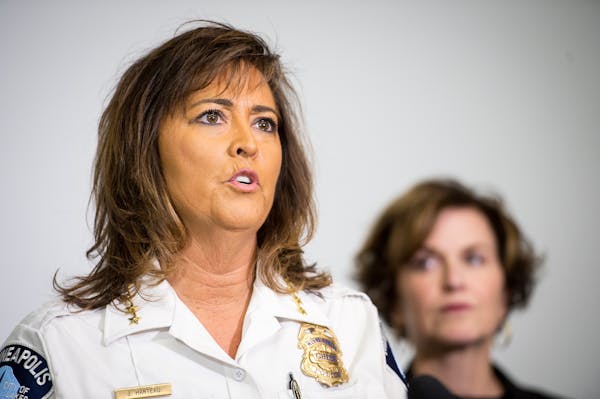Arrests are on the decline again in Minneapolis, with police statistics showing the city is on pace to record its lowest arrest rate in 17 years.
The number of arrests fell nearly 9 percent through March 20 — the last day for which reliable data are available — compared with the same period last year, department statistics show. The percentage drop reflects the number of arrests reported to the FBI's Uniform Crime Reporting Program, from homicides and burglaries to drunken driving. If the trend holds true for the full year, it would be the fewest number of arrests since at least 2000.
Arrests have steadily decreased in the past decade and a half. Last year, officers made 11,953 arrests for Part I and II crimes, roughly two-thirds fewer than they made in 2000. Police are on pace to record even fewer arrests this year. The drop-off largely is fueled by a decrease in Part II arrests, for less serious crimes like vandalism, prostitution and DWIs.
Police statistics show that the decline was most pronounced in the downtown area: roughly 8 percent fewer Part I arrests and 41 percent fewer Part II arrests.
But with the rise in crime, department officials are quick to point to increases in arrests for burglary (from 43 in 2016 to 63 so far this year), auto theft (47 to 67) and aggravated assault (141 to 164), which includes shootings.
"It really shows our officers are working hard and holding people responsible for violent and invasive crimes that can have a profound impact on the residents we serve," Chief Janeé Harteau said in a statement Friday.
Violent crime is up about 6 percent citywide. Meanwhile, so-called Part I crimes, which lump in serious offenses such as homicide and rape with property crimes, have jumped 18 percent.
Philosophical shift
There's little consensus about what's causing the drop in arrests.
City Council President Barb Johnson said she has noticed a philosophical shift in the way the city is policed.
Harteau and Mayor Betsy Hodges have repeatedly said that police cannot "arrest their way out of" the problem of rising crime.
Last week, city officials announced a downtown anti-crime initiative that includes an increase of about 15 officers downtown this summer. The strategy didn't sit well with Johnson.
"I think it's a real challenge if you don't arrest people who are disturbing the peace, who are screaming at police," said Johnson, a staunch backer of the police. "I don't buy that everybody is mentally ill."
Johnson suspects the trend is the result of a phenomenon where demoralized cops are reluctant to do their jobs out of fear of facing harsh scrutiny. "Consequences mean something to people and I don't think that we should take that away," she said on Friday.
Last year, officers on the North Side faced accusations of a monthslong work slowdown that has resulted in a 51 percent drop in stops in the Fourth Precinct, along with a 45 percent drop in arrests.
A relief for some
The decrease in arrests and stops had some communities breathing a sigh of relief, particularly in majority-minority neighborhoods, some of which have long had a tense relationship with police.
A 2015 ACLU report found that blacks in Minneapolis were nearly nine times more likely than whites to be arrested for a low-level offense, often after a traffic stop.
At the time, police officials said the reasons for the decline were more complicated.
Harteau said it was a combination of several factors: a shrinking police force combined with greater community engagement and officers "being more selective with what types of enforcement action is necessary."
On Friday, she expounded on her reasoning.
" 'Selective' means our area of focus is dependent upon crime trends and patterns," Harteau said through a spokesperson. "Directives are given by precinct leadership based upon their specific crime prevention strategies."
Libor Jany • 612-673-4064 Twitter: @StribJany

Trail section at one of Minnesota's most iconic spots closing for rehab

Will 'shotgun only' zone for deer in southern Minnesota be abolished?

Four Minnesotans catch salmonella in outbreak linked to basil sold at Trader Joe's

